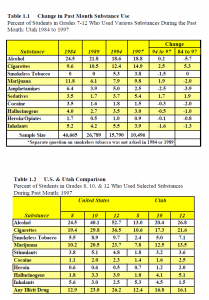Dr. Stephen Bahr and Cassandra J. Dorius, Sociology
My research objective was to obtain valid estimates of adolescent drug use in the state of Utah, including an estimate of change over the past thirteen years and a comparison with adolescent drug use across the United States.
The data were obtained from the 1997 School Survey of Adolescent Drug Use and Non-Use under the direction of Dr. Stephen Bahr, Brigham Young University. Over 10,000 students in grades 7-12 were surveyed throughout the state of Utah in the spring of 1997. The research design was cross-sectional, with youth self-reports on behavior, attitudes and attachment. Permission for the youth survey was received by representatives for the state and each school district, principles, teachers whose classrooms were chosen, parents, and youth. Every planning district, and 38 of the 40 school districts, participated in the study. Principle and teacher cooperation was high, and only in cases of special activities or testing was the survey not given. Less than one half of one percent of the parents refused to allow their child to participate in the study. The overall return rate was 82 percent within the classrooms sampled.
Similar studies were conducted by Dr. Bahr in 1984, 1989, and 1994 at the request of the Utah Division of Substance Abuse (UDSA) to assess the needs of Utah’s thirteen planning districts in terms of drug education. Our final 1997 report was given to the UDSA in August of 1998 in order to help estimate how the drug education moneys should be allocated according to need for the upcoming school years.
The national data were obtained from the 1997 Monitoring the Future Study of U.S. students in grades 8, 10 and 12. About 15,000 students were surveyed from each grade level to provide an accurate cross-section of students throughout the United States. The procedures and questionnaires used by Johnston et al., 1997 were similar to those used in the Utah survey.
The trends in drug use over the past decade are presented in Table 1.1. Since 1994, cigarettes, marijuana, and sedatives have seen substantial increases in the proportion of students who reported use. There were significant decreases in the use of smokeless tobacco, amphetamines, cocaine and inhalants, with the largest decreases being smokeless tobacco and amphetamines. There was little change in the percent of students who used hallucinogens or heroin during the three year period. Since 1984, the most noticeable increase in use occurred with cigarettes followed by sedatives. There were significant decreases in the use of alcohol, amphetamines, marijuana, cocaine and inhalants. Hallucinogens and heroin use decreased slightly in the thirteen year time period, and smokeless tobacco was not assessed.
United States and Utah comparisons (see Table 1.2) show that the proportion of students who reported using alcohol, cigarettes, and marijuana was substantially lower in Utah than in the Untied States as a whole. In addition, the proportion of students who reported using any type of illicit drug was considerably less in Utah than in the aggregated United States.

